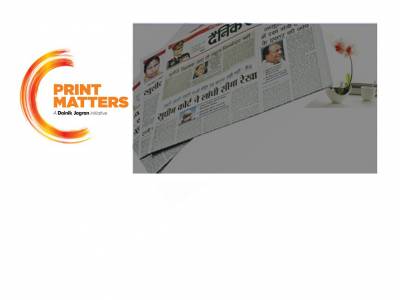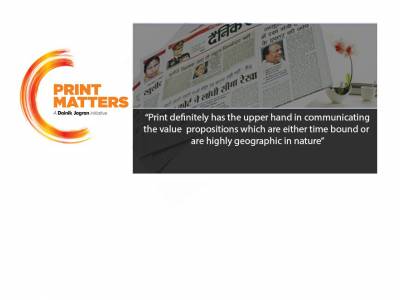Why brands’ bond with print continues to grow stronger in a digital era
Print media has continued to thrive in India despite facing multiple challenges – rising cost of newsprint, imposition of GST at 5 per cent on the advertising revenues of the print industry, rapid adoption of digital and mobile, rise of video content, etc. According to GroupM’s ‘This Year, Next Year’ 2018 report, print accounted for the second largest share of the Indian M&E sector, growing at 3 per cent to reach Rs 303 billion in 2017. Print media is estimated to grow at an overall CAGR of approximately 7 per cent till 2020 with vernacular at 8-9 per cent and English slightly slower. Zenith’s Advertising Expenditure Forecasts, too, state that print will thrive on regionalisation.
On the traditional media front, the Parliamentary elections in H1 2019 will stimulate advertising from the back half of 2018. The GroupM report states that print will see a slight uptick in 2018 from the elections, with key markets in demand. The growth rate for newspapers is estimated at 4.2 per cent with English papers growing slightly slower than Hindi and regional languages.
It’s no wonder then that brands continue to bank heavily on print advertising as the medium is also seen as enhancing the brands’ credibility. As stated by Sanjeev Shukla, Chief Marketing Officer, Muthoot Pappachan Group, “Medium’s credibility and the emotions that a medium evokes, rubs on to the brand advertising in the medium. Newspapers are still seen as a relatively serious medium and hence, help get that imagery for the brands therein.”
Adding to this, Amit Sethiya, Head – Marketing, Syska Group, said, “Print medium definitely completes the core IMC planning of any brand. There are enough and more examples of brands which are truly online, but even then they have to rely on traditional medium like print to acquire new customer base. In order to register the brand presence in print, the players need to plan consciously the exposures and frequencies accordingly, which makes the entire participation costly and very thought through, which is not the case when it comes to an easy medium like digital. This invariably brings more credibility to the brand which consumes print media.”
Key strengths of print advertising
The key strength of print advertising, especially newspapers, according to Shukla is that it is totally focussed to the market one wants to reach and there is least spill over. Comparing TV with print medium, he pointed out that a TV advertisement “just passes by” and so, if a record is not taken or action is not taken there and then, there’s a miss. “But newspaper is available for a longer time. It doesn’t vaporise post reading!,” he remarked.
Continuing further with the comparison between TV and print, Shukla noted, “As it’s popularly said about us, we are ‘Argumentative Indians’. We love to discuss and debate over a variety of topics over endless cups of Chai! TV can’t be carried to a Chai Shop or to a gully-corner. But newspaper can be. It is therefore, a point of reference. It thus, gives more life to the paper and to the advertisements therein.”
He further said that the term, watching television does not take into account various distractive activities that viewers are engaged in, including snacking, chatting, mobile phone addiction and so on. “Viewers particularly switch off when ad-break happens…mostly to take a toilet break. But when a newspaper is being read, it’s being read and the ad cannot be skipped.”
Sethiya pointed out that despite the digital revolution, India is perhaps the only country where newspaper readership is still increasing. Majority of Indians still rely heavily on newspapers for their daily dose of updates out of sheer habit and curiosity. Shukla, too, highlighted the fact especially in smaller towns and rural India reading is still a habit, which will take time to go, and hence, newspaper readership continues to grow.
With newspapers getting fragmented in terms of genres, languages and formats, it gives easy targeting metric to the marketers. Sethiya pointed out, “In the last 10 years, we have seen a lot of interesting innovations brought out by the print industry, which has helped the brands to not only capture the attention but also connect with the readers. There are a lot of households where a single newspaper still caters to the entire family and hence, an increased possibility of reaching out to more numbers of consumers.”
Both Shukla and Sethiya were one in that print is not a snacking medium. According to Shukla, “By its very nature, the newspaper readership profile is also of a relatively serious profile.”
For Sethiya, print definitely has the upper hand in communicating the value propositions which are either time bound or are highly geographical in nature and these attributes ensure that the medium is serious and relevant.


















Share
Facebook
YouTube
Tweet
Twitter
LinkedIn